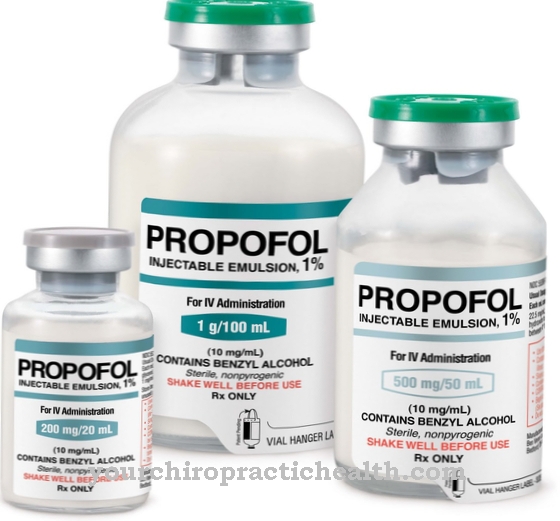As Efavirenz a non-nucleoside reverse transcriptase inhibitor is called. The drug is used to treat HIV infections.
What is efavirenz?
The active ingredient efavirenz (EFV) belongs to the group of non-nucleoside reverse transcriptase inhibitors (NNRTIs). The drug is used as a pure enantiomer and is used to treat HIV infections such as AIDS. It is part of a combination antiretroviral treatment.
Efavirenz was approved as a medicinal product in Europe in 1999 by the EMEA (European Medicines Agency). However, because resistance to the active substance quickly develops in the context of monotherapy, the non-nucleoside reverse transcriptional inhibitor must always be taken together with another antiretroviral substance that the patient has never received before. Efavirenz was already on the market in North America before it was approved in Europe.
Efavirenz is available as a monopreparation under the trade name Sustiva® in Germany. There is also a combination preparation called Atripla®.
Pharmacological effect
Viruses are not able to take care of their own reproduction. For this purpose they need the reproductive system of the cells that have attacked them. To achieve this, the viruses infiltrate the genetic material of the cells into their own genetic material. The cells are given blueprints that they use to produce the viruses. This process is more difficult with HI viruses, as their genetic makeup is different from that of mammals and humans.
In order for the genetic material of the HI viruses to get into human cells, it is necessary to “rewrite” it. The enzyme reverse transcriptase takes care of this change. In this way, the HIV virus can transform its genome in such a way that it can be incorporated into the human genome without difficulty.
As efavirenz belongs to the group of reverse transcriptase inhibitors, it has the ability to block the active site of reverse transcriptase. As a result, the enzyme is no longer able to rewrite the virus' genetic makeup. The body's cells classify the information as foreign and therefore no longer reproduce it. This counteracts the production of new HI viruses.
This process reduces the viral load, which can delay the onset of AIDS. It also reduces the symptoms of HIV infection, which in turn improves the patient's quality of life.
Efavirenz is 99 percent bound to plasma proteins in the blood. Its concentration in the cerebrospinal fluid is three times higher than in the blood plasma. The half-life of the active ingredient is around 50 hours. One third of the excretion of efavirenz occurs in metabolite form in the urine. The rest of the substance escapes from the organism via stool without any changes.
Medical application & use
The only area of application for efavirenz is in HIV infections in which there is a weak immune system in the human body. The agent can be used in adult and adolescent patients as well as in children from three years of age.
As a virus inhibiting drug, efavirenz acts directly against the HI viruses. However, it is also possible to counteract the onset of AIDS or to slow it down.
Ingestion of high-fat foods can affect the absorption of efavirenz. It increases by about 50 percent. The medication is usually taken in the evening on an empty stomach before going to bed. Since the half-life of efavirenz is long, a single dose of the agent per day is sufficient. Efavirenz can be taken both as a solution and in the form of film-coated tablets.
Risks & side effects
There is a risk of side effects from using efavirenz, primarily affecting the central nervous system (CNS). The affected patients often suffer from tiredness, drowsiness, sleep problems, nightmares and dizziness. Especially in the initial phase of efavirenz treatment, up to 50 percent of all sick people are affected by these undesirable side effects.
Other side effects can include difficulty concentrating, anxiety, depression, headache, abdominal pain, diarrhea, nausea, rashes on the skin and itching. In most cases, these side effects will improve after one to four weeks. However, symptoms persist in 10 to 20 percent of all those affected, so it is advisable to switch to another preparation.
Occasionally, there are other side effects such as acute inflammation of the liver (hepatitis), acute pancreatitis (pancreatitis), mood swings, euphoria, aggressiveness, paranoia, delusions, restlessness, memory problems, movement disorders, disorders of balance, convulsions, visual disturbances, confusion and thoughts of suicide which can lead to a suicide attempt.
If skin blisters, changes in the mucous membrane, flaking skin and fever develop on the skin during treatment, you should urgently consult your doctor and the therapy may be discontinued.
Since the side effects are not infrequently associated with mealtimes, it is advisable to give efavirenz on an empty stomach. In some cases the drug causes disturbances in the distribution of body fat. This reduces the fat on the body and face while it increases in the abdomen.
There are also some contraindications to taking efavirenz. It must not be used if the patient is hypersensitive to the active ingredient or has severe liver damage. Strict medical control is necessary in the case of kidney dysfunction, liver disease, epilepsy, psychiatric disorders in advance or resistance to other HIV drugs.
Efavirenz should only be used during pregnancy if no other treatment options are available. Animal experiments have shown that the drug has harmful effects on the child.



























